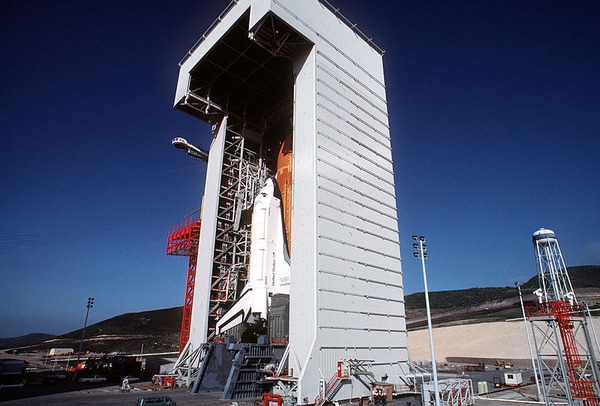Target Moscow: Soviet suspicions about the military uses of the American Space Shuttle (part 1)by Bart Hendrickx and Dwayne A. Day
|
| Various people over several decades have alleged that this study led the Soviet leadership to approve their own space shuttle program, popularly known as Buran. This is inaccurate. |
Recently, a Russian researcher named Pavel Shubin reported on a new discovery in Russian space history archives: a 1976 study about the ability of the American space shuttle to “dive” on Moscow in a sneak attack, releasing a nuclear weapon that could destroy the city and Soviet military command and control facilities. The existence of the study has been long-rumored. It is an important historical document for the Soviet space program, and over the decades numerous writers have referred to its alleged impact on Soviet space policy. Shubin wrote a blog post about his discovery, and produced a transcription of the study. (See: “Nuking Moscow with a Space Shuttle,” The Space Review, December 23, 2019)
But a certain mythology has also grown around the study. Various people over several decades have alleged that this study led the Soviet leadership to approve their own space shuttle program, popularly known as Buran. This is inaccurate—truly a myth—because the Soviet space shuttle program was in fact approved before the study was released. What remains unknown is what its actual legacy was, but as a Cold War document, it is very interesting for what it says about its authors and how they viewed NASA’s Space Shuttle program.
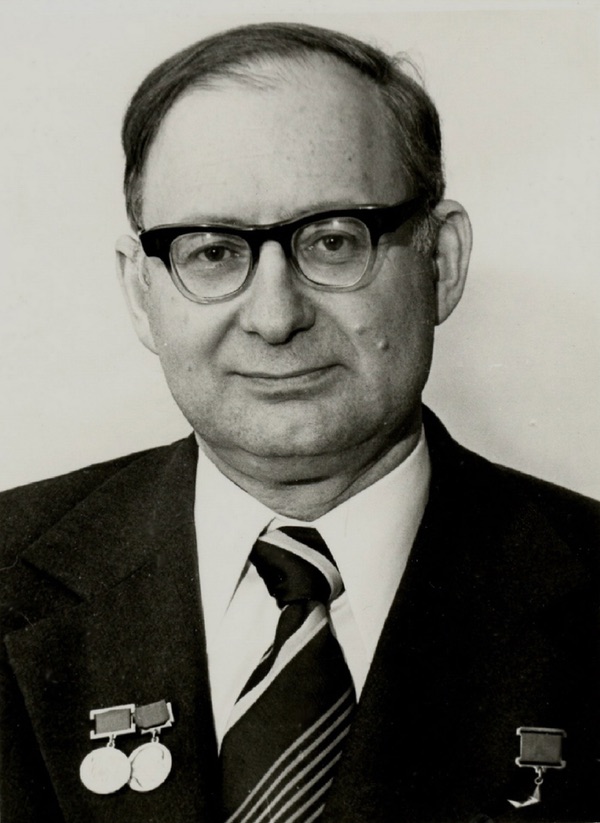 Dmitry Okhotsimsky, a co-author of the 1976 report on military applications of the shuttle. |
The alleged military origins of the American Space Shuttle program
The 1976 study was written by Dmitry Okhotsimsky, who was then head of Department 5 at the Institute of Applied Mathematics, and Yuri G. Sikharulidze, who also worked at the Institute. Okhotsimsky was one of the most brilliant applied mathematicians in the Soviet Union during the Cold War and, according to Russian space historian Asif Siddiqi, his contribution to mathematical modeling in the Soviet missile and space program was tremendous. “He was in charge of the original mathematical (ballistics) modeling for the R-7 ICBM, the early artificial satellites (including Sputnik), the early Luna probes, the Zond circumlunar project, and the later Luna sample return missions,” Siddiqi noted in a recent email. Siddiqi added that he had a solid reputation, did not become involved in impractical or unsubstantiated projects, and his department was involved in many classified projects. Okhotsimsky passed away in 2005, but Sikharulidze is still alive.
Now that their study is public, it is apparent that Okhotsimsky and Sikharulidze completely misunderstood the origins and purpose of the American Space Shuttle program, and made some highly dubious conclusions about its capabilities and missions. They began their report by providing evidence that the American shuttle was primarily intended for military purposes. First, they cited the 1974 Aeronautics and Space Report of the President to the US Congress, which described the Defense Department as the main potential user of the shuttle. This, however, was an inaccurate translation of what the American report actually said, namely that DoD would be an important future user of the Space Shuttle, but not the main one.
Okhotsimsky and Sikharulidze also referred to the establishment of two joint NASA/DoD bodies to oversee the shuttle program:
- the Aeronautics and Astronautics Coordinating Board, chaired by NASA Deputy Administrator George Low and the Director of the Office of Defense Research and Development Malcolm Currie
- the Space Transportation Committee, chaired by NASA Associate Administrator for Manned Space Flight Dale Myers and the Assistant Secretary of the Air Force for Research and Development Walter LaBerge
These three factors alone were enough for Okhotsimsky and Sikharulidze to conclude that the shuttle was being developed mainly for military purposes.
| Okhotsimsky and Sikharulidze were also stuck on the fact that shuttle would not be cheaper to operate compared to expendable rockets, and they did not think that it offered advantages for launch or orbital operations. |
But as numerous other American sources indicated at the time, NASA was planning to use the shuttle to launch a wide range of civilian payloads. For instance, in 1973, NASA signed an agreement with the European Space Research Organization (ESRO) to build a science laboratory to be carried in the shuttle’s payload bay, and by 1974, European companies had begun work on it. Thus, there was ample evidence of extensive NASA plans for civilian use of the shuttle, but Okhotsimsky and Sikharulidze simply did not accept it.
Although the shuttle would launch some military satellites from the US East Coast, most military and intelligence satellites operated in high inclination orbits and could only be launched from Vandenberg Air Force Base in California. The Air Force had plans to build a shuttle launch facility at Vandenberg, at the site of Space Launch Complex 6 (or “Slick-6,”) which was originally erected in the 1960s to launch the Titan IIIM and the Manned Orbiting Laboratory. But SLC-6 would not be activated for several years after the Florida launch facilities. The shuttle did indeed have a role to play launching military and intelligence satellites, but there was voluminous public information—available to any Soviet diplomat with a subscription to Aviation Week & Space Technology—indicating that it was primarily a civilian program.
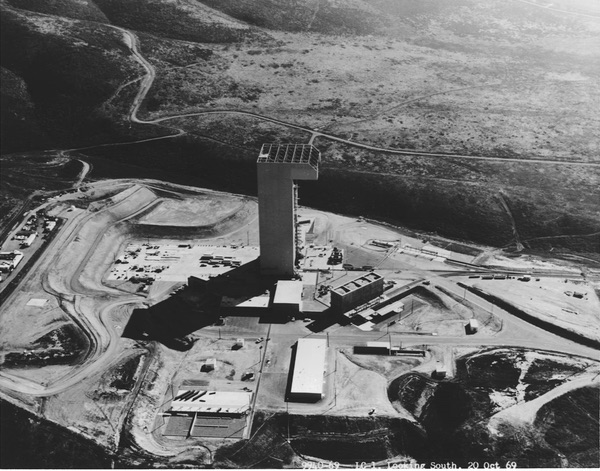 Air Force photo of the incomplete Space Launch Complex 6 facility at Vandenberg Air Force Base in California in late 1969. SLC-6 was built for the Manned Orbiting Laboratory program and then mothballed. It was later developed for launching space shuttles from the US West Coast, which alarmed people in the Soviet space program. (credit: from the Roger Guillemette Collection) |
Shuttle inefficiencies
Okhotsimsky and Sikharulidze were also stuck on the fact that shuttle would not be cheaper to operate compared to expendable rockets, and they did not think that it offered advantages for launch or orbital operations. In their study they wrote that the shuttle did not provide any major advantages over expendable systems for launch costs. They noted that NASA assumed that the Space Shuttle did offer some cost benefits thanks to its reusability (estimated cost for launching one kilogram was $350–500 for the shuttle versys $2,000–3,000 for Atlas/Titan II, $1,200–1,500 for Saturn IB, and $500 for Saturn V.) The shuttle design also would make it possible to recover crew and payload in most launch abort scenarios, and the lower g-forces placed less stringent requirements on crew training compared to the Apollo program. However, the authors argued that because the orbiter itself accounted for about two thirds of the mass placed into orbit, an expendable vehicle with a launch mass and engine system similar to those of the shuttle could place into orbit a payload that would be approximately three times heavier.
As for in-orbit performance, Okhotsimsky and Sikharulidze noted the low maneuvering capability of the orbiter due to its high mass (which they gave as 68 tons, although it was actually around 100 tons). According to their analysis, the in-orbit delta-V would amount to no more than 190 meters per second (after extracting the delta-V needed for the Orbital Maneuvering System insertion burn and the de-orbit burn.) In contrast, a 68-ton upper stage (loaded with 60 tons of propellant) launched by an expendable launch vehicle would offer a delta-V of more than 2 kilometers per second. The shuttle therefore was inferior to an expendable system.
Okhotsimsky and Sikharulidze concluded that the main benefits of the shuttle appeared only during the atmospheric portion of its flight, in particular its ability to deviate from its flight trajectory by about 1,100 nautical miles (2,040 kilometers), as demanded by the Pentagon, enabling it to return to the launch site after a single orbit around the Earth, whereas capsules have a cross-range of no more than 200–500 kilometers and could not return to Vandenberg after one orbit. The authors stated that accurately landing a capsule with a 14-ton payload is “very problematic, but not impossible.”
Therefore, they concluded that one of the main objectives of the American space shuttle was to fly single-orbit missions from Vandenberg. They noted in passing that the high cross-range capability would be needed for emergency scenarios. They were referring to what NASA called an “abort-once-around”, a scenario in which the shuttle would be unable to reach a stable orbit but have sufficient velocity to circle the Earth once and return about 90 minutes after launch. However, the fact that the high cross-range capability was demanded by the Air Force and not NASA, in their view, indicated that this capability was not primarily required for abort scenarios.
Okhotsimsky and Sikharulidze also pointed out that the required capacity of the shuttle to land with a maximum payload mass of 14.5 tons was probably not coincidental. This was exactly the same mass that could be placed into orbit by the shuttle when launching into a 104-degree inclination, 200-kilometer orbit from Vandenberg. Okhotsimsky and Sikharulidze also referred to “several reports” saying that payloads with a mass of up to 11–13 tons are enough to satisfy all military requirements. Therefore, they concluded that the shuttle’s payload capacity was most likely determined by the need to place 14.5-ton military payloads into polar orbits from Vandenberg. Its maximum capacity of 29.5 tons to 28-degree orbits from Cape Canaveral was no more than an accidental by-product of this military requirement.
Having determined that single-orbit military missions from Vandenberg are the main “raison d’être” for the shuttle, the authors then examined what the objectives of such missions could be. Referring to a 1975 Russian publication on the shuttle, they stated that shuttle launch azimuths from Vandenberg range from 140 to 201 degrees, which translates into orbits with inclinations of between 56 and 104 degrees. Any of these launch azimuths, the authors concluded, would carry the shuttle over East European or Soviet territory on its first revolution around the Earth (an area from “the western borders of the German Democratic Republic [East Germany] and Czechoslovakia to the eastern borders of the USSR”). Okhotsimsky and Sikharulidze wrote: “This leads one to conclude that the orbiter will likely be used as an orbital bomber or military reconnaissance vehicle.” The wide range of launch azimuths, the low orbital altitude, and the fact that the targets for photography or attack would be approached from the south (while most of the Soviet early-warning systems faced northward) would make it difficult to predict or detect such missions.
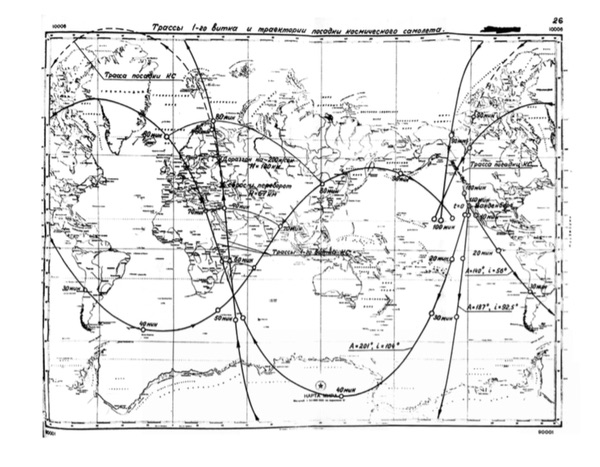 Illustration from the IPM study showing the ground tracks of shuttles launched from Vandenberg with orbital inclinations of 56, 92.5, and 104 degrees. |
Bombing missions
Okhotsimsky and Sikharulidze stated in their report that the shuttle would offer several advantages over intercontinental ballistic missiles, as well as so-called “global missiles,” the term the Russians used for rockets that would place nuclear weapons into orbit, after which they would de-orbit themselves and approach US territory from the south. The Soviet Union actually performed flight tests of such a system using the R-36 missile of the Yangel design bureau in the late 1960s and early 1970s (in the West this was known as a Fractional Orbit Bombardment System, or FOBS, and the Russian development of such a system may have led Okhotsimsky and Sikharulidze to assume that the Americans sought a similar capability.) While an ICBM needs just 30 or 40 minutes to reach its target, it spends much of its time at high altitudes (up to 800–1000 kilometers), making it easy to detect. In contrast, because it flies over the South Pole, the shuttle would need 70–80 minutes to reach its target, but flying at an altitude of 185–200 kilometers and approaching the Soviet Union from the south, it would be much harder to detect by Soviet early warning systems. An orbiting nuclear weapon is also easy to detect and its trajectory can be quite easily predicted, making it easy to take countermeasures. It also has a much lower strike accuracy, so they thought the shuttle would be better for this mission.
| Okhotsimsky and Sikharulidze then provided an alarming scenario for the American shuttle: a mission with the aim of dropping a “special payload” (in other words, a bomb) on Moscow. |
Okhotsimsky and Sikharulidze stated that the shuttle’s crew would make it possible to increase flexibility and even to call off the operation at the last moment. Strike accuracy would be increased by the ability to accurately determine the position of the orbiter before the de-orbit burn. With the help of the US Air Force’s Global Positioning System (GPS) then in development, that accuracy was expected to improve to 50 meters by 1981, and to 10 meters by 1984.
Okhotsimsky and Sikharulidze then provided an alarming scenario for the American shuttle: a mission with the aim of dropping a “special payload” (in other words, a bomb) on Moscow. The shuttle would enter the atmosphere at an altitude of 110 kilometers some 17 minutes after the de-orbit burn at 30 degree northern latitude. Four minutes after entry interface, at an altitude of 67 kilometers and with the orbiter at 47 degrees north, it would drop the bomb, which would hit its target about three to four minutes later at a speed varying between 200 and 500 meters per second. Detection would be made even more difficult by the fact that the orbiter and the bomb would be enveloped by a cloud of ionized gas at altitudes between 45 and 75 kilometers which cannot be penetrated by radio signals. Meanwhile, the orbiter would “turn in such a way that its lift would be aimed upwards with a roll angle of about –30°.” This would enable it to “come out of its dive and perform a lateral manoeuvre” to place it on a trajectory back to Vandenberg. Not having enough speed to reach the launch site, it would fire its Orbital Maneuvering System (OMS) engines (ideally at an altitude of about 100 kilometers) to provide a delta-V of about 200 meters per second. Exiting the atmosphere at a speed of 7.2 kilometers per second at 61 degrees north, the orbiter would reach a maximum altitude of 120 kilometers and then begin its final descent to Vandenberg. In contrast to the initial dive, which would take just 7.5 minutes, this gradual descent would take about 35 minutes.
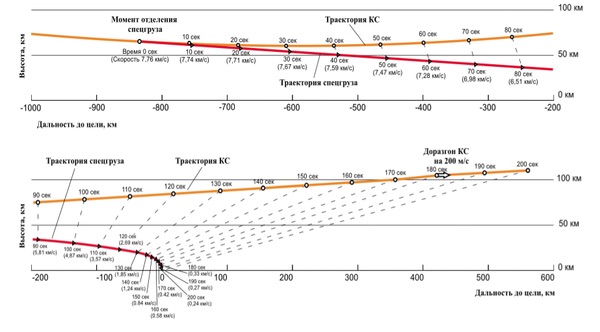 Illustration from the IPM study showing the shuttle’s dive into the atmosphere and subsequent re-boost maneuver. The light line represents the trajectory of the shuttle and the dark line that of the “special payload”. |
One major problem with the scenario portrayed by Okhotsimsky and Sikharulidze was that the shuttle did not have a bomb bay on the bottom of the spacecraft. Instead, it had a payload bay with large doors mounted on its top that could not be opened during reentry. They did not address this issue in their report.
Okhotsimsky and Sikharulidze expected the shuttle to be used to strike “major administrative and military-industrial complexes,” the sudden destruction of which would offer the “attacking side” a major advantage. The shuttle could also be used to destroy mobile targets or “new targets of high military importance detected at the last moment.”
Reconnaissance missions
Because ICBMs were seen as the main means of delivering a nuclear strike, Okhotsimsky and Sikharulidze expected that the main task of the shuttle would be to perform regular single-orbit “patrol flights” for reconnaissance purposes, for instance to make detailed images of high-priority targets earlier selected with the help of reconnaissance satellites. The shuttle’s reusability and expected short turnaround time would make this mission possible in their view. They assumed that the need to regularly return these high-value military payloads back to Earth explained the DoD requirement for the shuttle to be able to return to Earth with a payload of 14.5 tons. In the conclusion of their report, the authors seem to describe the patrol missions as a prelude to the use of the shuttle in a wartime situation, saying they could be used “to create an atmosphere of tension and permanent threat” and to “exert pressure” on the Soviet Union.
| Okhotsimsky and Sikharulidze also devoted one section of their report to the possible “scientific and technological” uses of the shuttle, but considered them as a “good cover” for its primary purpose, namely military missions from Vandenberg. |
As a further confirmation of the suspected mission scenarios, Okhotsimsky and Sikharulidze referred to two mission profiles studied by NASA and called 3A and 3B (said to be two out of just four typical flight profiles studied by NASA.) Both of these were single-orbit missions, the first to deliver a 14.5-ton payload to a polar orbit and land with a 1.13-ton payload, and the second to return a 11.3-ton payload from a 104-degree inclination 185-kilometer orbit. Okhotsimsky and Sikharulidze added that the 3A type trajectory would take the shuttle over Moscow. Interestingly, the authors found out about these mission scenarios from an article published in 1975 in Flight magazine and authored by David Baker, the current editor-in-chief of the British Interplanetary Society’s Spaceflight magazine. According to Baker in a recent email, the Soviets remained very interested in and suspicious about the Space Shuttle’s missions once it began flying in 1981.
How they reached this conclusion about the 3A mission is puzzling. With its 104-degree inclination, it would not fly over the Soviet Union. In fact, the irony of the situation is that these two profiles were specifically designed to avoid flying over the Soviet Union. Furthermore, both missions were deleted from NASA’s requirements for the shuttle, although it is unclear if Okhotsimsky and Sikharulidze were aware of that fact.
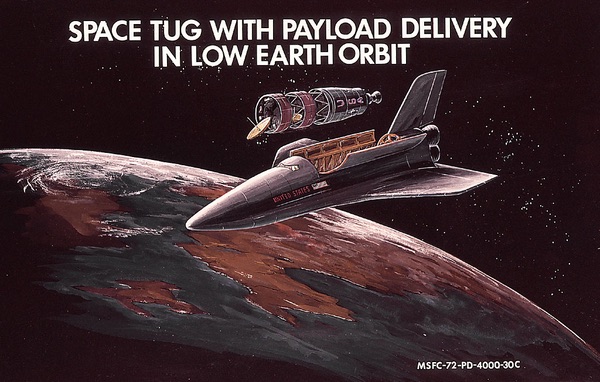 In order for the shuttle to place payloads into geosynchronous orbits and interplanetary trajectories, it needed an upper stage. In the early 1970s, that was to be a reusable “Space Tug” that could be recovered. The Air Force was responsible for the Space Tug’s development. (credit: NASA) |
Space tugs
Okhotsimsky and Sikharulidze also discussed the likely purpose of what they called “an interorbital tug,” with an initial mass of 25–27 tons and using liquid oxygen and hydrogen, needed to deliver payloads from the shuttle’s relatively low orbits to much higher orbits (all the way to geostationary orbit), or return payloads from high orbits back to the shuttle.
Although the tug was being built “under Air Force control,” the authors believed missions requiring the tug were not a crucial part of the shuttle program. First, tugs with the same mass could easily have been developed much earlier and launched by expendable launch vehicles such as the Saturn 1B at no significant extra cost. Second, the Air Force was trying to cut development costs to $400–500 million and was not making any obvious efforts to speed up the development of the tug, which was not expected to become operational until 1984.
In fact, by the time of this study, the Air Force had decided to develop shuttle upper stages in two phases, starting with a lower performance version and later developing a higher performance stage. The lower performance version became the expendable Interim Upper Stage, or IUS. The Air Force abandoned efforts to develop a higher-performance upper stage and NASA had to take charge, beginning work on the powerful Centaur-G stage.
The authors noted that the Air Force placed much lower requirements on the tug than NASA (which mainly needed it for missions to geostationary orbit). In an odd leap in logic, they interpreted this lower Air Force interest as an indication that the Air Force primarily wanted to use the tug to inspect or knock out enemy navigation, communications, and reconnaissance satellites.
Scientific and technical uses of the Space Shuttle
Okhotsimsky and Sikharulidze also devoted one section of their report to the possible “scientific and technological” uses of the shuttle, pointing out in particular the scientific value of Spacelab missions and the shuttle’s ability to service satellites in orbit, return them to Earth for refurbishment, assemble large structures in orbit, and replace the fleet of expendable launch vehicles. They also noted that with 60 shuttle missions per year, the United States would be able to annually place 1,700 tons of cargo into orbit and return about 800 tons, giving it a significant edge over the Soviet Union. However, they described the civilian missions of the shuttle from Cape Canaveral as a “good cover” for its primary purpose, namely military missions from Vandenberg.
Next week: The Soviet response to the American space shuttle
Note: we are temporarily moderating all comments submitted to deal with a surge in spam.
